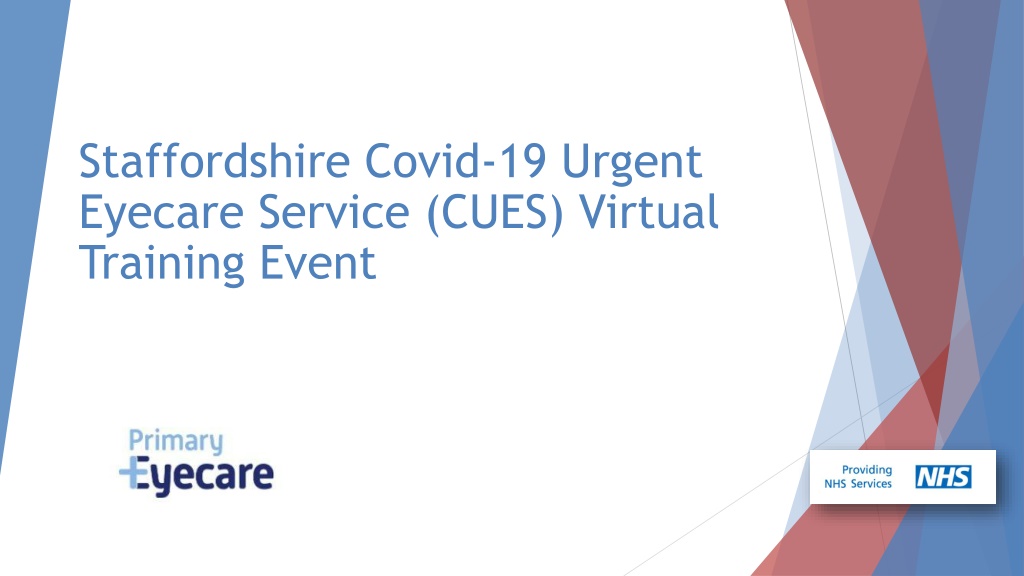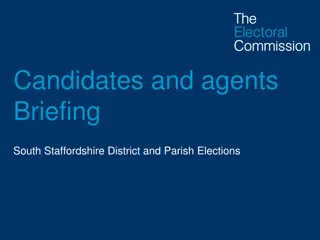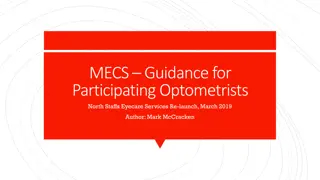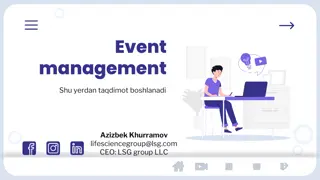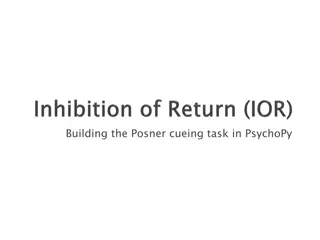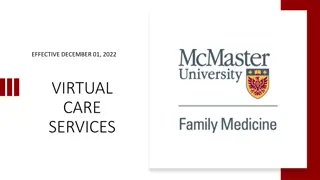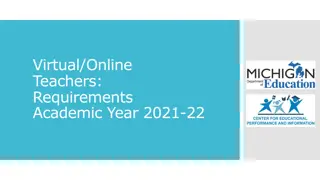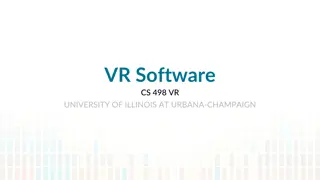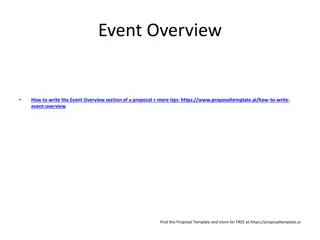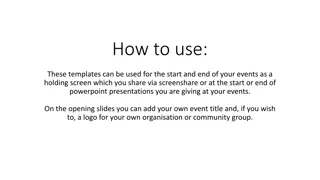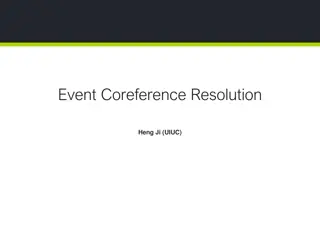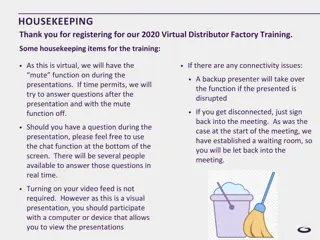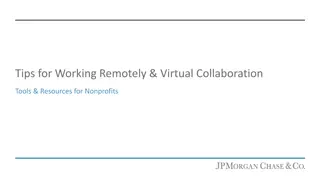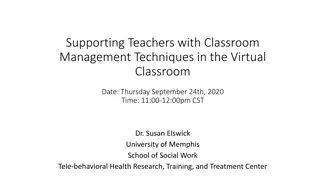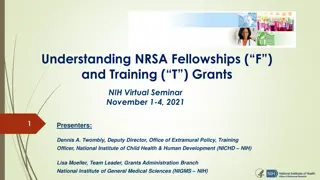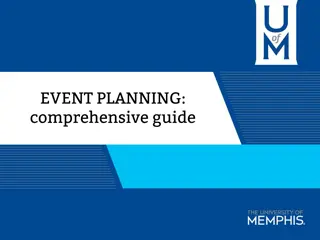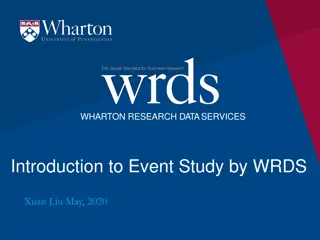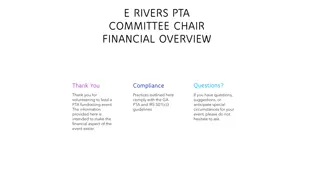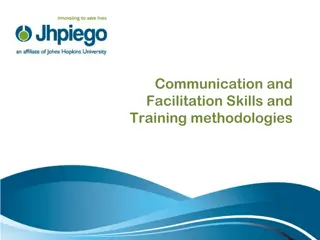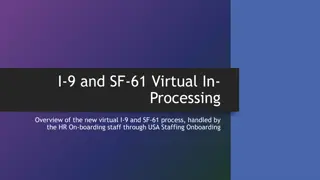Staffordshire CUES Virtual Training Event Overview
Explore the highlights of the Staffordshire Covid-19 Urgent Eyecare Service (CUES) Virtual Training Event, featuring introductions, covered CCG areas, service fees, OCT assessments, and imaging procedures within CUES to enhance eyecare delivery. Learn about the key aspects discussed by experts and how to efficiently utilize OCT technology for better patient outcomes.
Download Presentation

Please find below an Image/Link to download the presentation.
The content on the website is provided AS IS for your information and personal use only. It may not be sold, licensed, or shared on other websites without obtaining consent from the author. Download presentation by click this link. If you encounter any issues during the download, it is possible that the publisher has removed the file from their server.
E N D
Presentation Transcript
Staffordshire Covid-19 Urgent Eyecare Service (CUES) Virtual Training Event
Welcome Staffordshire LOC Irfan Razvi, Chairman Mark McCracken, Vice Chairman Introduction Primary Eyecare Services Jagdeep Singh, Clinical Governance & Performance Lead (Staffordshire, Cheshire and Merseyside)
CCG areas currently covered by CUES North Staffordshire Stoke on Trent Stafford and Surrounds Cannock Chase South East Staffordshire and Seisdon Neighbouring areas that also have the service Cheshire Black Country Derbyshire Worcestershire Wolverhampton
Fees Telemedicine or face to face appointment (to include follow-up) Service Delivery North Staffordshire 47.50 Stoke on Trent 47.50 Stafford and Surrounds 47.00 Cannock Chase 47.00 South East Staffordshire and Seisdon 47.00 Face to face with OCT/Independent Prescribing optometrist (when triage form indicates required) additional 25
Use of OCT/IP bolt-ons Jagdeep Singh - Clinical Governance and Performance Lead, Specialist Optometrist
OCT Assessment within CUES When an OCT assessment is carried out ( 25 OCT fee being claimed for) you must include an upload of a DICOM file. If this isn t possible (due to OCT software), still images or slices along with the macular thickness report should be uploaded instead Most OCT models have capability to export a DICOM file. Zeiss, Heidelberg, Nidek, Topcon Static OCT image 5-10Mb Full DICOM file 55Mb Option to capture OCT static images/videos using tablet, mobile phone and then upload onto Opera Patient cannot be charged privately for an OCT within CUES
OCT/Image capture within CUES Please ensure you know how to export images from your imaging equipment (e.g Fundus camera, OptoMap) to add to your CUES referrals. If you don t know how to export images please speak to the local sales representative for the manufacturer of your equipment If images, videos can be exported from the imaging equipment software, then you can upload them onto Opera Opera is able to accept the following file types: JPEG or JPG DCM or DICOM images (commonly exported from OCT machines) MP4 - video files from slit lamps and similar WMV - a video format that can be used to present OCT files PDF - for visual fields, or letters or other documents BMP - standard Windows image format TIFF or TIF files - larger image types If a referral is warranted, the attachments can be viewed within HES across multiple IT platforms
Transferring a patient to an OCT practice To identify a practice that has OCT availability, use the DOS Explorer in Opera (under General tab) Enter patient age, select OCT services for Clinic Type and select the relevant CCG If your practice is not listed on DOS Explorer as providing OCT (or IP) and you are able to provide either of these services, please use the blue speech bubble on Opera or email hello@referral.support Call OCT practice ahead before transferring patient via Opera Double dipping Practice A triages a patient and then carries out a Telemedicine/Face to Face. After Telemedicine/Face to Face it is decided that patient requires an OCT/IP assessment. Patient is then referred to Practice B who carries out OCT/IP Practice A gets Telemedicine Fee only: 47.50/ 47.00 (No fee if triaged and then referred to OCT/IP practice) Practice B gets full tariff including OCT/IP: 47.50/ 47.00 + 25.00 = 72.50/ 72.00 Aim is for patients to be seen at the appropriate practice at point of triage
IP Assessment within CUES To identify a practice that has IP availability, use the DOS Explorer in Opera (under General tab) Currently have 5 IP Optometrists across Staffordshire (North, South, East) Core and IP Optometrists are responsible for their prescribing. All optometrists are expected to work within their competency and experience when managing patients within CUES and refer to College of Optometrist Clinical Management Guidelines recommendations Primary Eyecare Services set up a cost centre. PES pay NHS England for the medicines and be charged back to the CCG at cost price FP10 s are still being chased with CCG. Difficulty accessing FP10 s nationally due to CCG authorisation If an IP optometrist without an FP10 sees a patient and needs to prescribe medicine on FP10 formulary they can issue a private prescription or if patient insists on NHS funded prescription can request the medication via GP. IP Optometrist will still get IP fee = 25.00 Send prescriptions to Pharmacies/GP s using NHS email addresses where needed Remote prescribing possible in the future
Staffordshire CUES Medicines Supply Mark McCracken Vice Chairman, Independent and Therapeutic Optometrist
Background MECS launched in Stafford & Surrounds and Cannock Chase CCG areas Appetite from patient feedback, GPs, LPCs and CCGs for enhanced pharmacy medicines supply under the service, free at point of delivery to the patient Launch of Staffordshire OTC policy in May 2018 for conditions which should not routinely be prescribed in primary care That which is considered to be self-limiting, and so does not need treatment as it will heal or cure of its own accord; Which lends itself to self-care, i.e. the person suffering does not normally need to seek medical advice and can manage the condition by purchasing OTC items directly. Conjunctivitis Dry Eyes/Sore(tired) eyes Exceptions
Optometrists Formulary Community Optometry Service Legal Classification P and POM (P for Bacterial Conjunctivitis Only) POM Available Preparation Drug Classification Drug Name Drug Type Various: -Eye Drops -Eye Ointments Chloramphenicol Anti -infective Anti-Bacterial Fusidic Acid Viscous Gel Anti -infective Anti-Bacterial Artificial Tears/Ocular Lubricants Artificial Tears/Ocular Lubricants Artificial Tears/Ocular Lubricants Artificial Tears Hypromellose P/CE Various Artificial Tears Carbomer 980 P/CE Various Gels Lacri-Lube, Xailin Night: eye Ointments Otrivine Antistine: eye drops Artificial Tears Liquid Paraffin P Antazoline and Xylometazoline (Otrivine-antistin) Anti- inflammatory Anti- histamine P P and POM [GSL for hayfever not to be used in Anti- inflammatory Mast Cell Stabiliser Sodium Cromoglicate Various Various Including preservative free (Multidose and single use) Artificial Tears/Ocular Lubricants Artificial Tears Sodium Hyaluronate CE
Covid Urgent Eyecare Service (CUES) First national lockdown March 2020 The need for a community acute eyecare service close to home - with added emphasis on looking after those patients who are self-isolating or who are shielding became more important than ever. CUES developed April 2020. Added enhancements of Optometry Independent Prescribing and OCT scanning Staffs LOC and PES negotiated with the Staffordshire LPCs and with the CCGs Medicines Optimisation team re an enhanced medicines supply service The introduction of a Community Pharmacy Optometry Supply Service (CPOSS) will further help to drive down the numbers of patients who need to travel to the GP or to the Trust setting for their eyecare and for their medicines supply
1) GSL/P Medicines (any community pharmacy can supply) Categories of Medicines Supply under the CUES Service 2) POM Medicines (CPOSS Pharmacy only) 3) Long Term Conditions (FP10 from GP) 4) IP Medicines (FP10 from IP Optom)
1) GSL/P Medicines (any community pharmacy can supply)
GSL/P Medicines Under NHSE/I s OTC policy *, the eye conditions to which the NHS Staffordshire and Stoke-on-Trent Self-care policy applies are: 1) Conjunctivitis 2) Dry eyes / sore (tired) eyes Remember: Self-care advice should always be considered before medication! * Guidance on conditions for which over the counter items should not routinely be prescribed in primary care: NHS England Guidance on conditions for which over the counter items should not routinely be prescribed in primary care
GSL/P Medicines Therefore, for any medicine supplied for either of the above conditions, the patient will be required to purchase OTC (regardless of age or personal finances). This includes all the GSL and P medicines in the standard CUES/MECS Optometrists Formulary i.e. Chloramphenicol (P), i.e. acute bacterial conjunctivitis only, for adults and children 2 years and over ** 1. Hypromellose 2. Carbomer 980 3. Liquid Paraffin (either Xailin Night or HYLO NIGHT [formerly VitaPOS] eye ointment) 4. Antazoline and Xylometazoline (Otrivine-Antistin) 5. Sodium Cromoglicate 6. Sodium Hyaluronate 7. ** The Optometrists Formulary (The College of Optometrists): Optometrists' Formulary (college-optometrists.org) 8.
GSL/P Medicines The CUES patient may buy GSL/P medicines OTC from the optical practice (if in stock) Alternatively, the CUES practitioner may signpost the patient to any community pharmacy for purchase of GSL/P medicines OTC, by means of the Optometrist Referral to Pharmacy form (available from Staffordshire LOC website Downloads tab)
Optometrist referral to Pharmacy The optometrist has recommended the following treatment to be purchased from your local pharmacy. Conjunctivitis: Type Treatment Dry eyes: Type Treatment Other eye condition: Type Treatment Optometrist s Name: Optometrist s Address: Date examined: NHS England has published guidance to primary care prescribers to not routinely prescribe over the counter medicines for common conditions. This includes minor eye conditions that can be treated successfully with an over the counter preparation from your local pharmacy. Note to Optometrist: only signpost patients to their GP for an NHS prescription request if the patient has a condition requiring long-term treatment, or an over the counter treatment is unsuitable.
2) POM Medicines (CPOSS pharmacy only)
POM Medicines There are only two POMs in the standard CUES/MECS optometrists Formulary. These are: Chloramphenicol (POM), i.e. First-line topical treatment for superficial ocular infections and as prophylactic following minor ocular trauma, for adults and children (1 month and over only if 1.0% eye ointment 2 years and over if 0.5% eye drops) ** 1. Fusidic Acid 2. ** The Optometrists Formulary (The College of Optometrists): Optometrists' Formulary (college-optometrists.org)
POM Medicines Following the discontinuation of Fucithalmic, the cost of Fusidic Acid eye drops is highly exorbitant. Therefore, Chloramphenicol should be used as first line However, Fusidic Acid is useful in instances of pregnancy or lactation, or in cases of known hypersensitivity to Chloramphenicol ** Pharmacies participating in the Community Pharmacy Optometry Supply Service (CPOSS) can supply POMs under a written order form issued by the CUES practitioner (available from Staffordshire LOC website Downloads tab) Alternatively, there is the option to print off a written order form from the CUES OPERA module POMs cannot be requested using the Optometrist Referral to Pharmacy form.
To be completed for patients who are exempt from NHS Prescription Charges Community Pharmacy Optometry Supply Service (CPOSS) Patient Name .. Date of Birth Cannock Chase CCG North Staffordshire CCG South East Staffordshire & Seisdon Peninsula CCG Stafford and Surrounds CCG Stoke-on-Trent CCG The Patient does not pay because: A is 60 years of age or over or is under 16 years of age B is 16, 17 or 18 and in full-time education Practice Name . D has a valid maternity certificate Practice Address Practice Phone Number E has a valid medical exemption certificate F has a valid prescription pre-payment certificate G has a prescription exemption certificate issued by Ministry of Defence L has an HC2 (full help) certificate To the Pharmacist. H entitled to Income Support (IS) or Income-related Employment and Support Allowance (ESA) Please supply to: K entitled to Income-based Jobseeker s Allowance (JSA) Patient Name Patient Date of Birth M has a Tax Credit Exemption Certificate Patient address S has a Pension Credit Guarantee (including partners) . U Entitled to Universal Credit and meets the criteria .. The information I have given is correct and complete and I confirm proper entitlement to exemption Preparation Required: I am the patient I am the patient s representative .. To be completed by the patient / patient s representative Optometrist Signature Date I received . (insert number) medicine(s) from this pharmacy Practioner GOC No . Written Oeder in accordance with Section 5 of Schedule 5, article 11(1)(a) of Statutory Insunstrument 1997 No 1830 as amended by Section 8 of Stautory Instrument 2005 No. 76 Signed ..Date No? Was evidence of exemption seen? Yes?
2021-01-19 12:17:54 CUES Written Order Private & Confidential SCRDONOTUSE Patient First Name TO THE PHARMACIST XXTESTPATIENTDZAWB Patient Surname 16-04-1928 Patient Date of Birth BRUNSTON PRACTICE GP Practice Name Flat 30 Dukes Palace Wharf Patient Address BRUNSTON PRACTICE, CINDERHILL, COLEFORD, GL16 8HJ Duke Street Duke Street NR3 3AT 9990243662 NHS Number Patient Telephone Drug name Dose Duration Eye(s) to treat Frequency Chloramphenicol 1.0% Ointment 4g One Drop for 48 hours after symptoms resolve Right 4 hourly for 2 days and then 4 times daily MATT JINKINSON Treating Clinician Electronic signature: 01-23523 Clinician GOC MATT JINKINSON Wet ink signature: PRIMARY EYECARE SERVICES LTD, UNIT 2.3, WAULK MILL, M4 6LN, AFW Practice Address Please read instructions carefully, dispose. of your used medication responsibly and do not share your eye medication with anyone else. Consult your optician or GP if you have any questions. Comments: This document has been produced electronically from within an NHS approved patient management system. If you require further details please contact the named clinician above. Written Order in accordance with Section 5 of Schedule 5, article 11(1)(a) of Statutory Instrument 1997 No 1830 as amended by Section 8 of Statutory Insytrument 2005 No. 76. The medication prescribed on this form may be supplied under the NHS from pharmacies participating in the NHS Community Pharmacy Dispensing Service for Community Optometry Minor Eye Conditions Service. This is free of charge except where a patient pays a prescriptinon charge. is under 16 years of age The patient doesnt have to pay because he / she Pharmacy Use Only Evidence not seen I declare the information I have given on this form is correct and complete. I understand that if it is not, appropriate action maybe taken. I confirm proper entitlement to exemption. To enable the NHS to check if I have a valid exemption and to prevent and detect fraud and incorrectness, I consent to the disclosure of relevant information from this form to and by the NHS Business Services Authority, the Department of Work and Pensions and relevant Local Authorities. Part 2: I have paid I am: The Patient The Patient's Guardian Signature Date: Address if different from that above This is the end of the Written Order. Produced in OPERA for Primary Eyecare Services
3) Long Term Conditions (FP10 from GP)
Long Term Conditions If the eye condition is secondary to a more general condition, then there is an exception from NHSE/I s OTC & DLCV policies, i.e. Patients prescribed OTC products to treat an adverse effect or symptom of a more complex illness and/or prescription only medications should continue to have these products prescribed on the NHS. Staffordshire LOC and Primary Eyecare Services Ltd advise that CUES practitioners can use this exception (sparingly) in requests for repeat medicines from GPs, quoting both the fact that this is a general exception from the OTC guidance, and quoting the underlined text with the reason for this deviation. In so doing, this will help prevent your prescription requests from being bounced back.
4) IP Medicines (FP10 from IP Optom)
IP Medicines The IP Formulary comprises an extended range of topical antibacterials, anti-virals, anti-allergy, steroids, antimuscarinic and NSAIDs, enabling IP optometrists to manage a broader scope of eye conditions under CUES. Any community pharmacy can dispense to an FP10 from an IP optom. It is recommended that both IP and non-IP CUES practitioners utilise the College of Optometrist s Clinical Management Guidelines (CMGs) *** *** Clinical Management Guidelines (The College of Optometrists): Clinical Management Guidelines (college-optometrists.org)
IP Formulary Below is the proposed IP formulary which is a minimum required to enable IP optometrists to deliver management of a broad range of ophthalmic pathologies within primary care avoiding onward referral to hospital, this is not an exhaustive list but acts as a starting point for further discussion with commissioner. Medication Antibacterial Ofloxacin 0.3% drops Ciprofloxacin 0.3% Gentamicin 0.3% Doxycycline 50mg capsules (28 pack) Anti-viral Ganciclovir 0.15% ointment Anti-allergy Olopatadine 1.0% Steroid Dexamethasone 0.1% (Maxidex) 10ml Dexamethasone with Hypromellose, Neomycin and Polymyxin B Sulfate (Maxitrol) eye ointment 3.5g Betamethasone 0.1% 10ml Prednisolone 0.5% 10ml Prednisolone 1.0% (Pred Forte) 10ml Fluoromethalone 0.1% 5ml Antimuscarinic Cyclopentolate 1.0% NSAIDs Ketoralac DM&D List Price IP Formulary 2.17 4.70 2.51 2.06 19.99 4.68 2.80 1.44 1.16 2.57 3.66 1.71 8.08 2.49 Primary Eyecare Services is a company limited by guarantee registered in England at Waulk Mill (2.3), 51 Bengal Street, Manchester M4 6LN. Registered no. 6722353.
Case History (1) 80-year-old male, currently receiving Pension Credit No long-term systemic health problems CUES practitioner has diagnosed acute bacterial conjunctivitis ? GSL/P, POM (CPOSS pharmacy), Long Term Conditions (FP10 from GP), or referral to IP Optom
GSL/ P Medicines patient will be required to purchase, regardless of age or personal finances Case History (1) Any community pharmacy can sell these, alternatively the patient may buy OTC from optical practice (if in stock)
Case History (2) 72-year-old female, not currently receiving any state financial aid Diagnosed with scleroderma CUES practitioner has diagnosed aqueous-deficient dry eye ? GSL/P, POM (CPOSS pharmacy), Long Term Conditions (FP10 from GP), or referral to IP Optom
Long Term Conditions write to GP to request a repeat prescription on FP10. Quote exception from OTC guidance Case History (2) Please include full name of drug, concentration, form, dosage, duration of course and therapeutic indication.
Case History (3) 21-year-old female, not currently receiving any state financial aid Corneal abrasion found on slit-lamp No sign of infective keratitis, no foreign body, no chemical or penetrating injuries ? GSL/P, POM (CPOSS pharmacy), Long Term Conditions (FP10 from GP), or referral to IP Optom
POM Medicine written order form to CPOSS pharmacy. Medicine will be supplied free at point of delivery to patient Case History (3) LOC will share a list of participating CPOSS pharmacies
Case History (4) 34-year-old male with symptoms of acute anterior uveitis, right eye only Has suffered 3 previous episodes No long-term systemic health problems ? Long Term Conditions (FP10 from GP), referral to IP Optom, referral to Eye Casualty
Referral to IP Optom (subject to same-day availability) Case History (4) Refer to ophthalmologist if, e.g. suspected granulomatous inflammation, bilateral involvement, underlying systemic aetiology, posterior segment involvement
The four categories of medicines supply under the CUES Service in Staffordshire 1. GSL/P Medicines (any community pharmacy can supply) Under NHSE/I s OTC policy *, the eye conditions to which the NHS Staffordshire and Stoke-on-Trent Self-care policy applies are: 1.Conjunctivitis 2.Dry eyes/sore (tired) eyes Remember: Self-care advice should always be considered before medication! Therefore, for any medicine supplied for either of the above conditions, the patient will be required to purchase OTC (regardless of age or personal finances). This includes all the GSL and P medicines in the standard CUES/MECS Optometrists Formulary, i.e. 1.Chloramphenicol (P), i.e. acute bacterial conjunctivitis only, for adults and children 2 years and over ** 2.Hypromellose 3.Carbomer 980 4.Liquid Paraffin (either Xailin Night or HYLO NIGHT [formerly VitaPOS] eye ointment) 5.Antazoline and Xylometazoline (Otrivine-Antistin) 6.Sodium Cromoglicate 7.Sodium Hyaluronate The CUES patient may buy GSL/P medicines OTC from the optical practice (if in stock). Alternatively, the CUES practitioner may signpost the patient to any community pharmacy for purchase of GSL/P medicines OTC, by means of the Optometrist Referral to Pharmacy form (available from Staffordshire LOC website Downloads tab) There are only two POMs in the standard CUES/MECS optometrists Formulary. These are: 1.Chloramphenicol (POM), i.e. First-line topical treatment for superficial ocular infections and as prophylactic following minor ocular trauma, for adults and children 1 month and over only if 1.0% eye ointment 2 years and over if 0.5% eye drops ** 2.Fusidic Acid Following the discontinuation of Fucithalmic, the cost of Fusidic Acid eye drops is highly exorbitant. Therefore, Chloramphenicol should be used as first line. However, Fusidic Acid is useful in instances of pregnancy or lactation, or in cases of known hypersensitivity to Chloramphenicol ** Pharmacies participating in the Community Pharmacy Optometry Supply Service (CPOSS) can supply POMs under a written order form issued by the CUES practitioner (available from Staffordshire LOC website Downloads tab). Alternatively, there is the option to print off a written order form from the CUES OPERA module. POMs cannot be requested using the Optometrist Referral to Pharmacy form. If the eye condition is secondary to a more general condition, then there is an exception from NHSE/I s OTC & DLCV policies, i.e. Patients prescribed OTC products to treat an adverse effect or symptom of a more complex illness and/or prescription only medications should continue to have these products prescribed on the NHS. Staffordshire LOC and Primary Eyecare Services Ltd advise that CUES practitioners can use this exception (sparingly) in requests for repeat medicines from GPs, quoting both the fact that this is a general exception from the OTC guidance, and quoting the underlined text with the reason for this deviation. In so doing, this will help prevent your prescription requests from being bounced back. The IP Formulary comprises an extended range of topical antibacterials, anti-virals, anti-allergy, steroids, antimuscarinic and NSAIDs, enabling IP optometrists to manage a broader scope of eye conditions under CUES. Any community pharmacy can dispense to an FP10 from an IP optom. It is recommended that both IP and non-IP CUES practitioners utilise the College of Optometrist s Clinical Management Guidelines (CMGs) *** * Guidance on conditions for which over the counter items should not routinely be prescribed in primary care: NHS England Guidance on conditions for which over the counter items should not routinely be prescribed in primary care ** The Optometrists Formulary (The College of Optometrists): Optometrists' Formulary (college-optometrists.org) *** Clinical Management Guidelines (The College of Optometrists): Clinical Management Guidelines (college-optometrists.org) CUES Medicines Supply Table 2. POM Medicines (CPOSS pharmacy only) 3. Long Term Conditions (FP10 from GP) 4. IP Medicines (FP10 from IP Optom)
CUES Remote Consultations Irfan Razvi Chairman and Independent Optometrist Staffordshire Local Optical Committee
Agenda Background and Types of Tele-medicine Application to CUES (COVID-19) & useful links Future of Remote consultations IR
Background of Telemedicine History of Telemedicine: Use of tech to deliver care at distance 1906: Wilhelm Einthoven, the inventor of the electrocardiograph, started experiments with remote consultations via the telephone network 1960: University of Nebraska Telepsychiatry, NASA biotelemetry 1991: UK Telemedicine pathways 2000: Scottish Telemedicine initiative 2020: COVID-19 driven explosion +++ (incl. CUES) USA, Canada & Australia more established pathways (prior to COVID-19)
Types of Telemedicine A remote consultation is an appointment that takes place between a patient and a clinician over the telephone or using video, as opposed to face-to-face. Types Store & forward: Px -- med images/ biosignals-- HCP Eg. Optometry/Ophthalmology, Dermatology, Radiology etc Remote monitoring: tech devices used to monitor clinical signs Px--HCP Eg. Monitoring of chronic diseases like CVD Real time interactive services: Immediate care for Px requiring attention using different tech platforms Eg. CUES Telephone & Video-consultations
Tele-Optometry: CUES application 1 CUES Step 1 Introduce yourself, where you are calling from. ID the patient and confirm contact details. Then outline why you are calling CUES consultation Make sure private setting just like F2F Check that Px is happy to proceed and private Start Consultation: Same order as F2F H&S/Exam/Management. Can begin with brief summary of what you already know (from reception triage) and then give opportunity for Px to add or update you. Start open ended, then ask more specific questions, increasing in detail, just as you would with F2F H&S.
Tele-Optometry: CUES application 2 Vital to record ALL aspects of TMC. Record some notes as you go along, Normal Px record or TM template. (If recorded, you always have option of referencing later on) For purpose of examination - photo request/ remote VA check etc -give precise instructions. Same for VC external eye examination. Be familiar/ have access to all referral pathways & key phone numbers Give clear Advice on Management. Where management plan/self-care, consider email to Px. If further/previous Px info reqd before decision make this clear. If looking likely that F2F required, get as much detail from H&S so as to minimise contact Outcome: Emergency referral / Advice & Guidance* &/or OTC recommend &/or Signed order /F2F (*Where treatment has been offered, book telephone follow up with option to cancel)
TOP TIPS FOR REMOTE CONSULTATION Records- whether written or electronic, telephone or video recording - secure storage : locked cabinet/PMS/Cloud/ Elect storage device. Clarity- More important when speaking remotely than with F2F (no mask!) Core H & S skills- will form backbone of Px management (more so than F2F) Px Perspective/ REASSURANCE - avoid long silences and try to maintain eye contact. Offer written guidance when reqd.
Video consultation platforms Evolving list of VC platforms but conformity needed. Worth mentioning AccuRx, which is free to use for all nhs.net account holders. Doctorlink is another free to use platform because of current NHSE VC pilot - ongoing in the Midlands region. Access details from LOC website/office. Other VC apps/ platforms are available this is a rapidly evolving industry so watch this space.. (HIPAA / NHS/ GDPR compliant)
Purpose and Validity Using remote consultations supports with coronavirus response by: (NHSEI/ GIRFT) preventing the transmission of the disease by reducing the need for patients to travel into hospital allowing clinicians to speak to patients who are unable to travel to hospital (e.g. patients in at risk groups, or due to self-isolation or travel difficulties) allowing clinicians to carry out clinical work from home (e.g. staff in at risk groups, or due to self-isolation or travel difficulties) supporting providers to meet increased demand in a particular locality. GOC statement August 2020 Use of technology during COVID-19 GOC statement High level principles for good practice in remote consultations and prescribing (Px Safeguarding)
